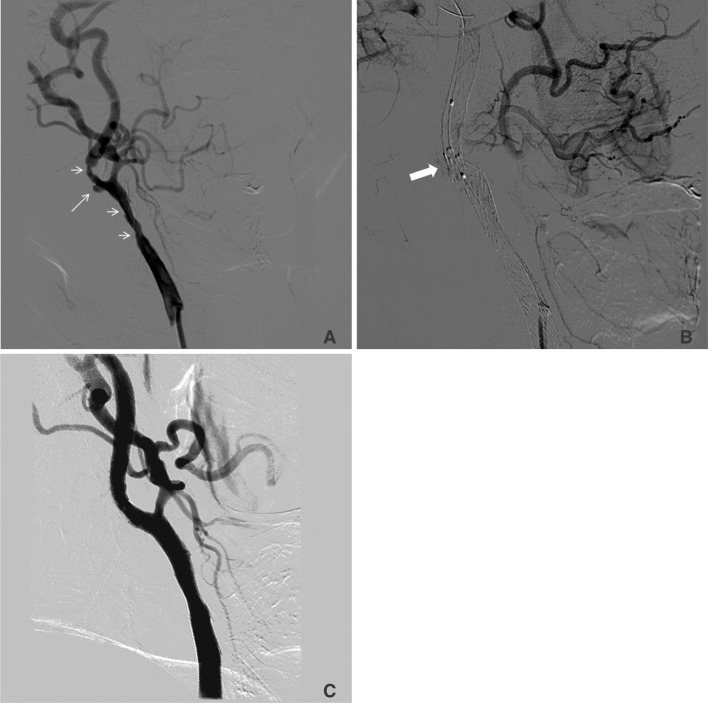Neurointervention.
2014 Feb;9(1):50-52. 10.5469/neuroint.2014.9.1.50.
Conjoined Stent Technique for Radiation Induced Long Segment Carotid Stenosis and Pseudoaneurysm
- Affiliations
-
- 1Advanced Neurocare Institute, GBH American Hospital, Udaipur-Rajasthan, India. atulabh@gbhamericanhospital.com
- KMID: 1910775
- DOI: http://doi.org/10.5469/neuroint.2014.9.1.50
Abstract
- Radiation induced carotid stenosis (RICS) is known but challenging complication of head and neck irradiation. Endovascular revascularization is preferred treatment modality than surgical revascularization. Sometimes endovascular treatment may be difficult in view of long segment of stenosis and associated pseudoaneurysm. We report a unique technique of carotid stenting named as "conjoined stent technique" in a challenging case of RICS with long segment of stenosis and pseudoaneurysm. In this technique we overlapped distal end of one stent with proximal end of second stent to occlude pseudoaneurysm. "Conjoined stent technique" may be viable option in case of long segment of RICS with associated pseudoaneurysm and alternative to flow diverters in extracranial carotid pseudoaneurysm.
MeSH Terms
Figure
Reference
-
1. Elerding SC, Fernandez RN, Grotta JC, Lindberg RD, Causay LC, McMurtrey MJ. Carotid artery disease following external cervical irradiation. Ann Surg. 1981; 194:609–615. PMID: 7294930.2. Fonkalsrud EW, Sanchez M, Zerubavel R, Mahoney A. Serial changes in arterial structure following radiation therapy. Surg Gynecol Obstet. 1977; 145:395–400. PMID: 888060.3. Atkinson JL, Sundt TM Jr, Dale AJ, Cascino TL, Nichols DA. Radiation-associated atheromatous disease of the cervical carotid artery: report of seven cases and review of the literature. Neurosurgery. 1989; 24:171–178. PMID: 2645540.
Article4. Rockman CB, Riles TS, Fisher FS, Adelman MA, Lamparello PJ. The surgical management of carotid artery stenosis in patients with previous neck irradiation. Am J Surg. 1996; 172:191–195. PMID: 8795530.
Article5. Kashyap VS, Moore WS, Quinones-Baldrich WJ. Carotid artery repair for radiation-associated atherosclerosis is a safe and durable procedure. J Vasc Surg. 1999; 29:90–96. PMID: 9882793.
Article6. Al-Mubarak N, Roubin GS, Iyer SS, Gomez CR, Liu MW, Vitek JJ. Carotid stenting for severe radiation-induced extracranial carotid artery occlusive disease. J Endovasc Ther. 2000; 7:36–40. PMID: 10772747.
Article7. Houdart E, Mounayer C, Chapot R, Saint-Maurice JP, Merland JJ. Carotid stenting for radiation-induced stenoses: a report of 7 cases. Stroke. 2001; 32:118–121. PMID: 11136925.8. Murros KE, Toole JF. The effect of radiation on carotid arteries. A review article. Arch Neurol. 1989; 46:449–455. PMID: 2650664.9. Cheng SW, Wu LL, Ting AC, Lau H, Lam LK, Wei WI. Irradiation-induced extracranial carotid stenosis in patients with head and neck malignancies. Am J Surg. 1999; 178:323–328. PMID: 10587192.
Article
- Full Text Links
- Actions
-
Cited
- CITED
-
- Close
- Share
- Similar articles
-
- Stent-assisted Angioplasty for Symptomatic Radiation-induced Carotid Stenosis
- Symptomatic Post Endarterectomy Common Carotid Artery Pseudoaneurysm Treated with Combination of Flow Diverter Implantation and Carotid Stenting
- Wingspan Stenting for Symptomatic Severe In-Stent Stenosis of a Closed-Cell Stent after Stent-Assisted Coiling of a Ruptured Intracranial Aneurysm
- Long-Term Outcomes of Stenting on Non-Acute Phase Extracranial Supra-Aortic Dissections
- Use of covered stent (CGuard) in the treatment of post-traumatic internal carotid artery pseudoaneurysm


